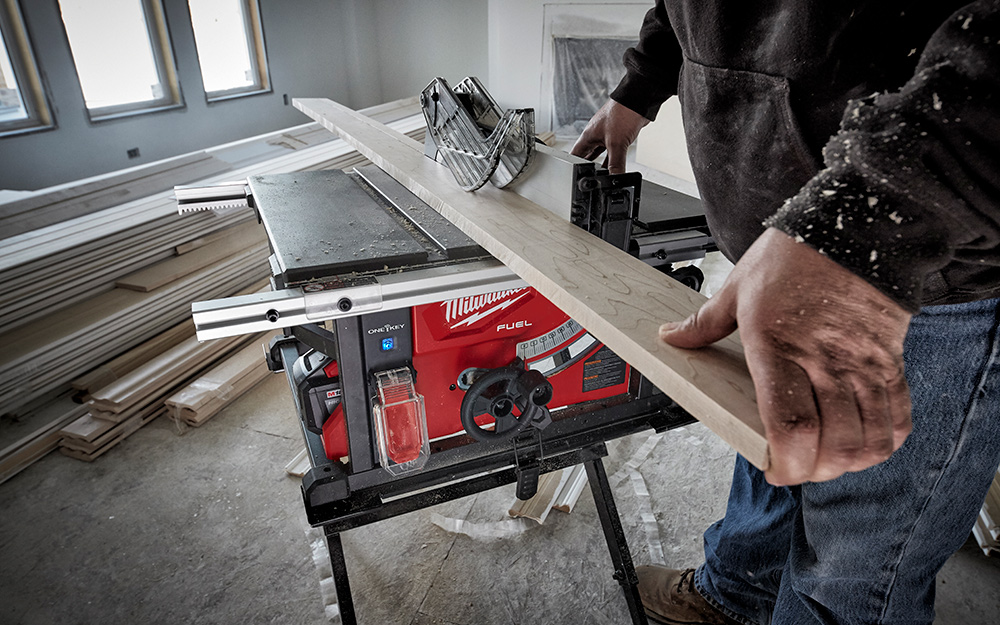A table saw is a great tool for making straight, accurate cuts. For beginners, the most important thing to remember when using a table saw is safety. Wear safety glasses and hearing protection at all times while operating the machine and keep your hands away from the blade at all times.
Set up the rip fence so that it’s parallel to the blade and set it to your desired width before making each cut. Place your material firmly against the fence before turning on the saw; then slowly push it forward into the blade with both hands. Be sure not to force or rush any cut as this can cause kickback which can be dangerous if you’re not careful.
After completing each cut, turn off power immediately and wait until blades stop spinning before moving wood pieces away from cutting area.
- Step 1: Understand the Basics of Table Saw Safety – Before you begin using a table saw, it is important to understand basic safety protocols
- Make sure that your work area is properly lit and free from obstructions
- Wear eye protection, ear plugs, and gloves for added protection
- Step 2: Read the User Manual – It is essential to read through the user manual before operating a table saw for the first time
- This will give you an understanding of all its features as well as provide instructions on how to use them correctly
- Step 3: Set Up Your Work Area – Place your material on a flat surface such as a workbench or table so that it can be easily cut without obstruction by other objects or people in your workspace
- Position your material securely with clamps if necessary so that it won’t move while cutting
- Step 4: Adjust Blade Height and Tilt Angle – Once everything is set up correctly, adjust the blade height and tilt angle according to what type of cut you are going to make (crosscut, rip cut etc)
- Refer back to your user manual for these specific instructions if needed
- Step 5: Start Cutting – With blade adjustment complete, turn on the power switch at either side of the saw base and begin making slow cuts into your material with steady pressure while guiding along its edge with both hands facing forward towards you away from any danger areas near or around the blade itself

Credit: www.homedepot.com
How Do You Use a Table Saw Step by Step?
Using a table saw is an essential skill for any woodworker. Before you begin, make sure that the blade is in good condition and securely attached to the saw. It is important to also check for any debris on or around the saw before use.
Once everything has been checked, adjust the fence and miter gauge so that it will be aligned with your cutting line when you start your cut. Place your material flat on the table and carefully align it with the blade guard, keeping both hands away from it at all times. Turn on the motor switch and slowly lower the material onto the spinning blade until it reaches its desired depth of cut.
When finished, gently lift up off of the blade and turn off power switch before removing material from table surface. With safety being paramount while using this tool, always remember to wear protective eyewear!
What is the Most Important Thing to Keep in Mind When Using the Table Saw?
The most important thing to keep in mind when using a table saw is safety. Make sure you read the instructions carefully and familiarize yourself with all of the components before attempting to use it. Always wear protective eyewear, gloves, and clothing while operating a table saw as well as keeping your hands away from the blade at all times.
Also make sure that your workspace is free of clutter and debris so that there are no tripping hazards or anything else that could potentially cause an injury. Finally, never leave your table saw unattended while it’s running; always turn off the power switch before leaving the area.
What Not to Do on a Table Saw?
When using a table saw, it is important to remember that safety should always be your top priority. To ensure adequate safety, you should never attempt to cut any materials without first ensuring the guard and splitter are in place and functioning properly. Additionally, do not try to remove material from the blade while it is running or use any tools other than those specifically designated for use with the table saw.
Furthermore, when cutting on the table saw, always make sure that all loose clothing and jewelry are secured so they don’t become entangled with the blade. Finally, never leave an operating table saw unattended as even a momentary distraction could result in serious injury or damage to property.
What Do You Really Use a Table Saw For?
A table saw is a versatile tool used for a variety of woodworking tasks. It can be used to make precise cuts, crosscuts and rip cuts in materials such as plywood, hardwoods, laminates, and veneers. Table saws are also useful for making rabbets (also known as dadoes), tenons, grooves and more specialized joinery techniques.
The most common use of the table saw is cutting large pieces of material into smaller parts that can then be assembled into larger projects such as furniture or cabinets. Additionally, they are great tools for creating decorative edges on projects like boxes or picture frames.
Using A Table Saw For The First Time | Beginner
How to Use a Table Saw Safely
Using a table saw is an important part of many woodworking projects, but it can be dangerous if not used properly. To ensure your safety when using a table saw, always wear eye and ear protection, unplug the machine before changing blades or adjusting settings, and never attempt to reach over the blade while it is running. Additionally, make sure that you are using the right blade for each job – dull blades require more force and can cause kickbacks – and use push sticks when necessary to keep your hands away from the cutting area.
Following these precautions will help you stay safe while using a table saw.
How to Use a Portable Table Saw
Using a portable table saw can be an effective way to make precise and accurate cuts in wood, plastic, or metal. To use it, first place the material you’re cutting on the surface of the saw and secure it firmly with clamps. Make sure that all safety features are engaged before turning on your saw.
Then adjust the depth and angle of cut according to your needs. When ready, turn on the power switch and begin making your cuts slowly and smoothly while keeping a firm grip on the stock being cut.
How to Use a Table Saw to Rip Boards
Using a table saw to rip boards is a common woodworking task. To do this, you’ll need to adjust the blade height and fence position of your table saw so that it will cut straight across the board. Then, make sure that you have a good grip on the board before pushing it through the blade with steady pressure.
Always use a push stick or jig to ensure that your hands stay away from the blades for extra safety. With practice and patience, you’ll be able to master using your table saw for ripping boards in no time!
How to Use a Circular Saw
Using a circular saw is a great way to make precision cuts in wood and other materials. To get the most out of your circular saw, it’s important to select the right blade for the job and use safety techniques when operating the tool. First, you’ll need to adjust the depth of cut on your saw so that it doesn’t cut too deep into whatever material you’re working with.
Next, be sure to wear safety glasses and hearing protection while using the tool as well as keeping hands away from where they could potentially come in contact with moving blades. Finally, when making your cuts, take care not to apply too much pressure – let gravity do most of the work!
Conclusion
Using a table saw for the first time can be intimidating, but with careful preparation and practice you’ll soon become an expert. It’s important to understand how to properly use a table saw and know your safety protocols before getting started. Make sure you read the manual, wear protective gear, and make sure that any riving knives or splitter blades are in place when using the tool.
With practice comes confidence and mastery of this powerful woodworking tool!
Table of Contents

